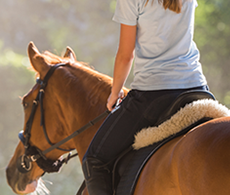
4 habits you need to unlearn to be a great rider
There’s a lot to think about when we’re riding, and sometimes, bad habits creep in that can affect our performance. We discover the four most common bad riding habits and find out how to undo them with expert advice from Lucinda Green.
Good riding should look effortless, with the horse and rider in total harmony. In fact, some of the best riders look like they’re not doing much at all in the saddle. This is because they have developed a good posture, balance and core strength to deliver the aids seamlessly and effectively to their horse.
‘Such good riding can take many years to achieve and even the best riders pick up bad riding habits along the way that need to be straightened out,’ says legendary eventer Lucinda Green. ‘The best way to deal with bad riding habits is to first identify them, because once you are aware, you can then begin working on correcting them.’
Here's a list of some of the most common bad riding habits, with advice on how you can correct them:
1. Poor posture (looking down, slouching and tipping forwards)
PROBLEM: Your head is one of the heaviest parts of your body, so when you look down, you alter your balance by tipping it forward. Balance is key to your effectiveness as a rider, as well as control and safety. Plus, when you look up in a specific direction, you signal to your horse where you want them to go. Sitting crooked and tipping forwards will also affect your horse’s balance.
SOLUTION: To practise keeping your head and eyes up, set up markers in the arena or field (or if you’re hacking, use trees or fence posts), and ride patterns to and around them. Keep your head and eyes up as you focus on each object. ‘Think about a piece of string attached to your hat that is drawn up towards the clouds to elongate and stretch your body upwards,’ explains Lucinda. ‘With time and repetition, looking ahead becomes second nature.’
2. Tension (not breathing)
PROBLEM: Many riders subconsciously hold their breath while riding due to being nervous, but this can create tension and results in a lack of focus that can affect your decision-making abilities. Tension in the rider also makes the horse tense, which means they cannot perform to the best of their ability.
SOLUTION: Don’t just breathe; breathe deeply. Diaphragmatic breathing is when you use your diaphragm muscle to breathe into the whole of both of your lungs, rather than just the upper part of the lungs. This is the most efficient way to breathe. It’s also important to monitor your breathing yourself. Don’t rely on someone else to point out when you aren’t breathing properly. ‘If your breathing is quick and shallow, take some time to slow your breathing down and take deep breaths as described above,’ says Lucinda. ‘It will help you relax and make concentrating on the task at hand much easier.’
Read our advice on more ways to help your nerves.
3. Bad hands (too restrictive, too high or too low)
PROBLEM: Heavy hands and those held too high or too low are as bad as hands that are unlevel and loose. Heavy hands result in the rider putting too much pressure on the horse's mouth and unlevel hands create an inconsistent and unbalanced contact. This can cause problems like head tossing and rearing.
SOLUTION: Imagine holding a baby chick in each hand when holding the reins – you don't want a grip that would squash them, but you need to hold them with enough force to prevent them from slipping through your fingers. Your thumbs should sit on top so that you don’t hold your hands flat with palms facing the ground. ‘It’s important to remember that you can’t keep the ideal grip on the reins all the time,’ says Lucinda. ‘Sometimes it will need to be much softer or stronger, depending on what is happening under you.’
She adds: ‘To keep your hands level and at the right height, try riding with a strap attached to the D-rings on your saddle, which you can loop your little fingers through. Developing a more secure seat will also improve the stability of your hands.’
See our top tips for achieving good hands.
4. Insecure leg (toes out, heels up, leg forward)
PROBLEM: Your lower leg affects your balance and stability in the saddle, as well as your upper body, so if the upper body moves forward, the lower legs drift back. If the upper body moves back, the lower leg drifts forward. This can unbalance you and therefore your horse, and make your leg aids less effective. A tight knee that grips and heels that rise up are also signs of imbalance in the saddle.
SOLUTION: Your legs should hang naturally against your horse’s side without gripping. This ensures that you can make subtle squeezing cues using your calf muscles and heel instead of having to kick. ‘Think of cuddling your horse with your legs,’ says Lucinda.
Always make sure your toes face the front, too; they should neither stick out, nor face inwards. ‘You also want to keep your weight down in your heel, with a bent knee,’ Lucinda advises. ‘If your heel rises, you become insecure and risk digging your heels into your horse and gripping.’
Read more on improving your seat in the saddle.
Watch our fun video for a quick refresher on how you can unlearn these four bad habits.
Do you struggle with a particular bad habit when riding? Share your problems and find out how others have overcome theirs on our Facebook page.
Do you think we’re doing a good job? If you do, please vote for us in this year’s Insurance Choice Awards. Plus, you’ll also be entered into a prize draw to win £1,000 (Ts&Cs apply)




